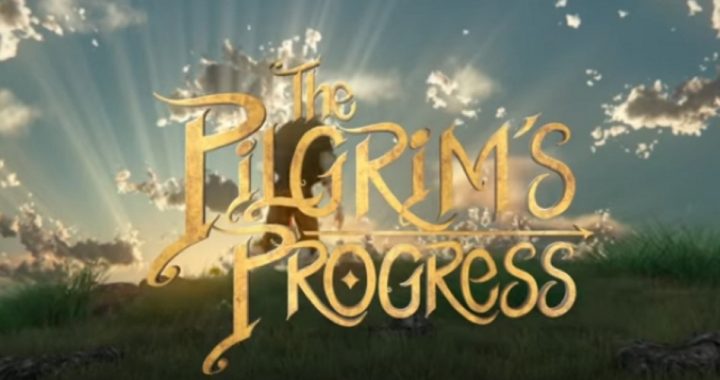
On August 25, Revelation Media hosted a free two-day online screening of its new animated film production The Pilgrim’s Progress, based on the classic book of the same name; it was so popular it was extended for two more days, and shown again over Labor Day weekend. Its limited theatrical release in April garnered cheers all around, and the online follow-up did not disappoint. The book is one of the most important works of fiction in Christendom, and this animated adaptation is appealing to adults and understandable by children. Part travelogue, part sermon, and part Lord of the Rings, it’s not to be missed. It’s now available on DVD.
Believed to be the second most printed book of all time, John Bunyan’s The Pilgrim’s Progress has been translated into more than 200 languages and hasn’t been out of print since first published in 1678. It’s also thought to be the first novel written in English. An allegory of the Christian life, it’s been retold in many forms. Audio, television, film, stage, operatic, and musical versions and excerpts abound, as do references in modern television, film, and printed texts.
This animated work follows Bunyan’s character Christian Pilgrim, who finds and reads a book detailing the path to the Celestial City. The Celestial City is characterized as the antithesis of Pilgrim’s home, the city of Destruction, a decaying dystopian machine run by Supervisors, descendants of Lux. The book promises the Celestial City has streets of gold, is full of peace, love, light, understanding, and forgiveness, and is the home of the King. Pilgrim leaves Destruction in search of the City, all the while toting his Burden (knowledge of his sin) characterized by a giant, prehistoric-looking arthropod that latches onto him, making his trek all the more miserable.
Bunyan can’t be accused of being subtle. Pilgrim is aided along his journey by Evangelist, Help, and Faithful, with instructions to stay on the straight path, “not to turn to the right or the left.” However, just like the ancient Israelites who “once again did evil in the sight of the Lord,” Pilgrim repeatedly leaves the path.
After an early diversion from the straight path facilitated by a deceitful being named Worldly Wiseman, which lands him at the Hill of Legality, Pilgrim is rescued by Help, who informs him, “You were convinced by the deceiver that hardship is something you wanted to avoid.”
Not to be overlooked are the characters portraying Satan and his demons. In his service is Supervisor, a wicked, winged being in charge of Destruction who’s bent on retrieving Pilgrim before he reaches the River of Death. Supervisor knows that beyond the River, Pilgrim cannot be reclaimed, and he employs all manner of deceit to trip up the traveler. He’s assisted by a fat little toady, who questions how to prevent the rest of Destruction’s residents from following Pilgrim. Supervisor tells him, “Start a rumor about what really happens in the Outer Realms. The less you tell them, the better. Let their imaginations fill in the blanks.” An astute viewer will immediately recognize this tactic used by modern media.
And later, in the Valley of Humiliation while clad in the Armor of God, Pilgrim battles fiercely with Apollyon (Satan), eventually wounding him, and some reviewers have found this sequence to be potentially frightening for children. How this is more frightening than one week of network TV remains unclear, but nevertheless, parents be warned. In fact, the film opens with this quote from C.S. Lewis regarding his thoughts about the subject: “Since it is so likely that children will meet cruel enemies, let them at least have heard of brave knights and heroic courage.” Christian Pilgrim meets those cruel enemies indeed, yet he’s fearful but courageous, fallible but forgiven, and desirous of God. We could ask worse.
The production is not an exact depiction of the book. Many of the original characters and scenes are missing, and some not in the original text have been added, but the plot line remains true to the book, charting Pilgrim’s progress through a world of struggle, testing, despair, fear, deception, loneliness, and hardship on his way to the Celestial City. Included are the authentic side trips to the House of the Interpreter, the Giant’s Doubting Castle, and the invaluable lessons learned in garish Vanity Fair. Occasional 21st-century humor lightens a scene, and the characters are delightful, engaging, and human. Production values aren’t that of Pixar, but who cares? It’s a great story.
If we have a criticism, it is this: Lost in transition from book to animated movie are critical scripture references — it’s hard to think of this story without the scriptural overlay, and it’s a missed opportunity for the application of God’s word — it could be viewed by anyone and interpreted outside a scriptural framework.
Perhaps as interesting to Christendom as the movie is the story of Bunyan’s own life, which resembled that of the Apostle Paul. Bunyan was not raised a religious man. After his marriage, he heard a sermon that began a period of intense spiritual struggle. It’s reported that he later overheard some women discussing a sermon, and became increasingly convinced to join the church. Eventually becoming a pastor, Bunyan was imprisoned for civil disobedience after English law prohibited preaching outside the auspices of the Church of England. He spent the next 12 years in jail. After his release, he was jailed for a second, shorter time. It was during the first imprisonment that he began work on The Pilgrim’s Progress.
Any film review is subject to the biases of the reviewer, and this is no exception. There’s no question to this reviewer why some faith films falter, as they speak to the already-converted. They rarely reach the unchurched, because they’re not made for the unchurched. But this production isn’t in that category. John Bunyan’s tale is a classic for a reason.
If there’s another lesson here, it’s about the value of books. Barna Group once reported that movies are the primary cultural influence among younger Americans. But as good as this film is, it’s no substitute for the book.
The Pilgrim’s Progress depicts timeless concepts, constructed for adults, and enjoyed by children. Suffering, despair, loneliness, hardship, temptation, deceit, seduction and demons, are all seasons of Christian life and growth. So is victory.
Image: screenshot from YouTube trailer



